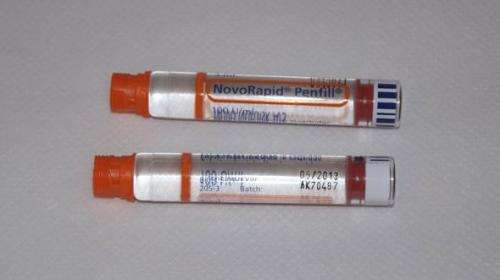Credit: Darren Lewis/public domain
In the largest study of its kind published to date, an international team of researchers in Mexico and the United States has discovered a strong genetic risk factor for type 2 diabetes that primarily affects Latin American patients, but is rare elsewhere. The work further characterizes a gene called HNF1A, responsible for a rare, inherited form of diabetes against which a widely available and inexpensive class of drugs is highly effective. The discovery offers important new clues about the population genetics of type 2 diabetes in Latin American populations, and suggests the possibility of tailored treatments based on patients' genetic makeup. The study appears in the June 11 issue of the Journal of the American Medical Association (JAMA).
"We've identified a genetic risk factor that is present in roughly 2 percent of Mexicans with type 2 diabetes, and its effects are substantial—raising a person's risk of developing the disease five fold," said corresponding author, Jose Florez, a Broad Institute associate member, an associate professor of medicine at Harvard Medical School, and an assistant physician in the Diabetes Unit and the Center for Human Genetic Research at the Massachusetts General Hospital. "It's a striking finding, which really underscores the power of the genetic approach."
Although type 2 diabetes is a major public health problem across the globe, Latin American countries carry a disproportionately heavy burden. In Mexico, for example, it is estimated that the disease affects over 14 percent of adults, which is approximately twice the rate in Europeans or white Americans. A number of factors are thought to drive this increased prevalence, including environmental as well as genetic influences.
Several large-scale genomic studies have been conducted to identify the genetic risk factors that contribute to type 2 diabetes. To date, more than 70 genomic regions have been implicated in the disease. However, the majority of these studies have focused on European populations, leaving a sizeable portion of the genomic landscape of the disease unexplored.
An international research team, known as the SIGMA Type 2 Diabetes Consortium, was formed to investigate the genetics of type 2 diabetes in Mexicans and other Latin American populations. In the current study, the team harnessed whole-exome sequencing, a method that decodes the genetic information within protein-coding genes—a relatively small portion of the genome called the "exome." Whole-exome sequencing has the potential to reveal even rare variations in the genetic code that are often not captured by other approaches but are more likely to affect protein function.
This work was conducted as part of the Slim Initiative for Genomic Medicine for the Americas (SIGMA), a joint U.S.-Mexico project funded by the Carlos Slim Foundation through the Carlos Slim Health Institute. SIGMA focuses on several key diseases with particular relevance to public health in Mexico and Latin America, including type 2 diabetes and cancer.
For the JAMA study, the researchers analyzed samples from nearly 4,000 participants, both people with type 2 diabetes and healthy controls, who were of Mexican or other Latin American ancestry. Their top results identified two genes: SLC16A11, which the team previously found to be linked with an increased risk of type 2 diabetes (findings published late last year in the journal Nature), and HNF1A.
The researchers uncovered a mutation within the HNF1A gene that is present in roughly 2 percent of Mexicans with type 2 diabetes, but in only one-tenth as many healthy adults, and is associated with a four- to five-fold increased risk of the disease. This variant of the gene has not been previously associated with the common form of type 2 diabetes, and is most frequently found in Latin American populations or other populations with Native American ancestry.
While the role of the variant is new, the HNF1A gene itself is well understood. When its function is fully disabled, a rare, inherited form of diabetes known as MODY results. MODY, or Maturity Onset Diabetes of the Young, generally emerges earlier than type 2 diabetes, often in the mid-twenties, and occurs even in the absence of pre-existing obesity.
In contrast, the HNF1A mutation identified in the current study, referred to as p.E508K, is thought to be less severe than those responsible for MODY, leaving some residual gene function intact. Patients with type 2 diabetes who carry this milder form are generally indistinguishable from other patients with type 2 diabetes in terms of age of onset and body weight.
These findings, while shedding new light on the population genetics of type 2 diabetes, raise some important questions about potential treatments—namely, whether drugs that preferentially work in patients with MODY will also work in patients with type 2 diabetes who carry the p.E508K variant. MODY that stems from HNF1A mutations is often successfully treated with a type of drug known as sulfonylurea because patients with MODY are much more sensitive to that drug than to metformin, the first-line drug typically prescribed in common type 2 diabetes.
"This is an outstanding discovery—one that helps explain the epidemic rates of type 2 diabetes in Latin American populations," said Teresa Tusie-Luna, project leader at the Instituto Nacional de Ciencias Médicas y Nutrición Salvador Zubirán and Principal Investigator at the Biomedical Research Institute, National University of Mexico. "But we must be mindful that, while the finding is associated with high levels of risk for the disease, we still do not know how the mutation behaves and if there is a specific therapeutic method can be safely applied in the clinic for individuals that carry the mutation. There is much more we need to learn."
More information: The SIGMA Type 2 Diabetes Genetics Consortium. "A low frequency variant in HNF1A has a large effect on type 2 diabetes risk in a Latino population." JAMA. June 11, 2014. doi:10.1001/jama.2014.6511
Journal information: Journal of the American Medical Association
Provided by Broad Institute of MIT and Harvard




















